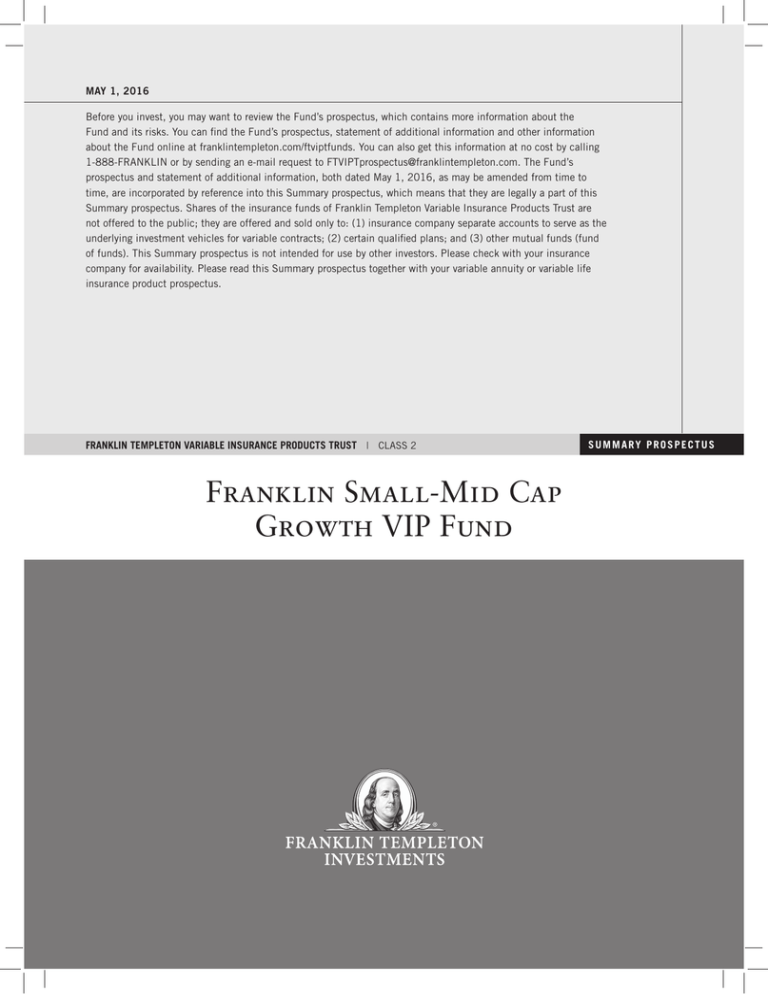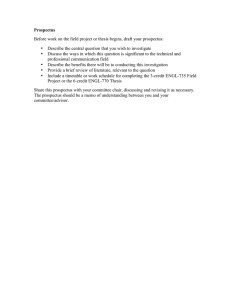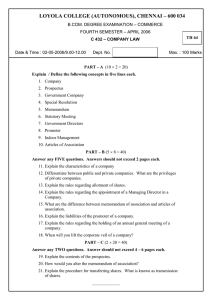
MAY 1, 2016
Before you invest, you may want to review the Fund’s prospectus, which contains more information about the
Fund and its risks. You can find the Fund’s prospectus, statement of additional information and other information
about the Fund online at franklintempleton.com/ftviptfunds. You can also get this information at no cost by calling
1-888-FRANKLIN or by sending an e-mail request to FTVIPTprospectus@franklintempleton.com. The Fund’s
prospectus and statement of additional information, both dated May 1, 2016, as may be amended from time to
time, are incorporated by reference into this Summary prospectus, which means that they are legally a part of this
Summary prospectus. Shares of the insurance funds of Franklin Templeton Variable Insurance Products Trust are
not offered to the public; they are offered and sold only to: (1) insurance company separate accounts to serve as the
underlying investment vehicles for variable contracts; (2) certain qualified plans; and (3) other mutual funds (fund
of funds). This Summary prospectus is not intended for use by other investors. Please check with your insurance
company for availability. Please read this Summary prospectus together with your variable annuity or variable life
insurance product prospectus.
FRANKLIN TEMPLETON VARIABLE INSURANCE PRODUCTS TRUST | CLASS 2
Franklin Small-Mid Cap
Growth VIP Fund
SUMMARY PROSPECTUS
S U M M A RY P RO S P E C T U S
Investment Goal
performance. During the most recent fiscal year, the
Fund’s portfolio turnover rate was 37.85% of the
average value of its portfolio.
Long-term capital growth.
Fees and Expenses of the Fund
This table describes the fees and expenses that you
may pay if you buy and hold shares of the Fund.
The table and the example do not include any fees
or sales charges imposed by variable insurance
contracts, qualified retirement plans or funds of
funds. If they were included, your costs would
be higher.
Annual Fund Operating Expenses
(expenses that you pay each year as a percentage of the
value of your investment)
Class 2
Management fees
0.77%
Distribution and service (12b‑1) fees
0.25%
Other expenses
0.04%
Total annual Fund operating expenses
1.06%
Example
This Example is intended to help you compare the
cost of investing in the Fund with the cost of investing
in other mutual funds. The Example assumes that
you invest $10,000 in the Fund for the time periods
indicated and then redeem all of your shares at the
end of the period. The Example also assumes that
your investment has a 5% return each year and that
the Fund’s operating expenses remain the same. The
Example reflects adjustments made to the Fund’s
operating expenses due to the fee waivers and/or
expense reimbursements by management for the 1
Year numbers only. Although your actual costs may
be higher or lower, based on these assumptions your
costs would be:
Class 2
1 Year
3 Years
5 Years
10 Years
$108
$337
$585
$1,294
Portfolio Turnover
The Fund pays transaction costs, such as
commissions, when it buys and sells securities
(or “turns over” its portfolio). A higher portfolio
turnover rate may indicate higher transaction costs.
These costs, which are not reflected in annual Fund
operating expenses or in the example, affect the Fund’s
Principal Investment Strategies
Under normal market conditions, the Fund
invests at least 80% of its net assets in the equity
securities of small-capitalization (small-cap) and
mid-capitalization (mid-cap) companies. For this
Fund, small-cap companies are companies within
the market capitalization range of companies in the
Russell 2500™ Index, at the time of purchase, and
mid-cap companies are companies within the market
capitalization range of companies in the Russell
Midcap® Index, at the time of purchase. Under normal
market conditions, the Fund invests predominantly in
equity securities, predominantly in common stock.
The Fund, from time to time, may have significant
positions in particular sectors such as technology
(including healthcare technology, technology services
and electronic technology), industrials, consumer
discretionary and healthcare.
The investment manager uses fundamental, “bottomup” research to seek companies meeting its criteria
of growth potential, quality and valuation. In seeking
sustainable growth characteristics, the investment
manager looks for companies that it believes can
produce sustainable earnings and cash flow growth,
evaluating the long term market opportunity and
competitive structure of an industry to target
leaders and emerging leaders. In assessing value, the
investment manager considers whether security prices
fully reflect the balance of the sustainable growth
opportunities relative to business and financial risks.
Principal Risks
You could lose money by investing in the Fund.
Mutual fund shares are not deposits or obligations of,
or guaranteed or endorsed by, any bank, and are not
insured by the Federal Deposit Insurance Corporation,
the Federal Reserve Board, or any other agency of the
U.S. government.
Market The market values of securities or other
investments owned by the Fund will go up or down,
sometimes rapidly or unpredictably. The market value
of a security or other investment may be reduced by
market activity or other results of supply and demand
2 - Franklin Small-Mid Cap Growth VIP Fund - Class 2
S U M M A RY P RO S P E C T U S
unrelated to the issuer. This is a basic risk associated
with all securities. When there are more sellers than
buyers, prices tend to fall. Likewise, when there are
more buyers than sellers, prices tend to rise.
Stock prices tend to go up and down more
dramatically than those of debt securities. A slowergrowth or recessionary economic environment could
have an adverse effect on the prices of the various
stocks held by the Fund.
Growth Style Investing Growth stock prices reflect
projections of future earnings or revenues, and can,
therefore, fall dramatically if the company fails to meet
those projections. Prices of these companies’ securities
may be more volatile than other securities, particularly
over the short term.
Smaller and Midsize Companies Securities issued by
smaller and midsize companies may be more volatile
in price than those of larger companies, involve
substantial risks and should be considered speculative.
Such risks may include greater sensitivity to economic
conditions, less certain growth prospects, lack of
depth of management and funds for growth and
development, and limited or less developed product
lines and markets. In addition, smaller and midsize
companies may be particularly affected by interest rate
increases, as they may find it more difficult to borrow
money to continue or expand operations, or may have
difficulty in repaying any loans.
Focus To the extent that the Fund focuses on
particular countries, regions, industries, sectors or
types of investment from time to time, the Fund may
be subject to greater risks of adverse developments in
such areas of focus than a fund that invests in a wider
variety of countries, regions, industries, sectors or
investments.
Liquidity From time to time, the trading market for
a particular security or type of security in which the
Fund invests may become less liquid or even illiquid.
Reduced liquidity will have an adverse impact on the
Fund’s ability to sell such securities when necessary
to meet the Fund’s liquidity needs or in response
to a specific economic event and will also generally
lower the value of a security. Market prices for such
securities may be volatile.
Management The Fund is subject to management risk
because it is an actively managed investment portfolio.
The Fund’s investment manager applies investment
techniques and risk analyses in making investment
decisions for the Fund, but there can be no guarantee
that these decisions will produce the desired results.
3 - Franklin Small-Mid Cap Growth VIP Fund - Class 2
S U M M A RY P RO S P E C T U S
Performance
The following bar chart and table provide some indication of the risks of investing in the Fund. The bar chart shows
changes in the Fund’s performance from year to year for Class 2 shares. The table shows how the Fund’s average annual
returns for 1 year, 5 years, 10 years or since inception, as applicable, compare with those of a broad measure of market
performance. The Fund’s past performance is not necessarily an indication of how the Fund will perform in the future.
The inclusion of the S&P 500® Index shows how the Fund’s performance compares to a group of securities in an
additional leading stock index.
Performance reflects all Fund expenses but does not include any fees or sales charges imposed by variable insurance
contracts, qualified plans or funds of funds. If they had been included, the returns shown below would be lower.
Investors should consult the variable insurance contract prospectus, or the disclosure documents for qualified plans or
funds of funds for more information.
Annual Total Returns
Average Annual Total Returns
For the periods ended December 31, 2015
43.57%
1 Year
38.15%
27.62%
5 Years
10 Years
-2.66%
8.80%
6.87%
Russell Midcap
Growth Index
(index reflects
no deduction for
fees, expenses or
taxes)
-0.20%
11.54%
8.16%
S&P 500 Index
(index reflects
no deduction for
fees, expenses or
taxes)
1.38%
12.57%
7.31%
Franklin Small-Mid
Cap Growth VIP
Fund - Class 2
®
8.69%
11.24%
10.85%
-42.50%
7.47%
-4.83%
-2.66%
®
No one index is representative of the Fund’s
portfolio.
2006
2007
2008
2009
2010 2011
Year
2012
2013
2014
2015
Best Quarter:
Q3’09
17.18%
Worst Quarter:
Q4’08
-27.15%
As of March 31, 2016, the Fund’s year-to-date return was
-3.11%.
4 - Franklin Small-Mid Cap Growth VIP Fund - Class 2
S U M M A RY P RO S P E C T U S
Investment Manager
Franklin Advisers, Inc. (Advisers)
Portfolio Managers
Edward B. Jamieson
President, Chief Investment Officer and Director of Advisers and
portfolio manager of the Fund since 2005.
Michael McCarthy, CFA
retirement plans are described in their disclosure
documents. Investors should consult the variable
contract prospectus, fund of fund prospectus, or
plan disclosure documents for more information on
fees and expenses imposed by variable insurance
contracts, funds of funds or qualified retirement plans,
respectively.
Executive Vice President of Advisers and portfolio manager of the
Taxes
Fund since 1995.
Because shares of the Fund are generally purchased
through variable annuity contracts or variable life
insurance contracts, the Fund’s distributions (which
the Fund expects, based on its investment goals
and strategies to consist of ordinary income, capital
gains or some combination of both) will be exempt
from current taxation if left to accumulate within the
variable contract. You should refer to your contract
prospectus for more information on these tax
consequences.
James Cross, CFA
Portfolio Manager of Advisers and portfolio manager of the Fund
since 2006.
Purchase and Sale of Fund Shares
Shares of the Fund are sold to insurance companies’
separate accounts (Insurers) to fund variable annuity
or variable life insurance contracts and to qualified
plans. Insurance companies offer variable annuity
and variable life insurance products through separate
accounts. Shares of the Fund may also be sold to other
mutual funds, either as underlying funds in a fund of
funds or in other structures. In addition, Fund shares
are held by a limited number of Insurers, qualified
retirement plans and, when applicable, funds of funds.
Substantial withdrawals by one or more Insurers,
qualified retirement plans or funds of funds could
reduce Fund assets, causing total Fund expenses to
become higher than the numbers shown in the fees
and expenses table above.
The terms of the offering of interests in separate
accounts are included in the variable annuity or
variable life insurance product prospectus. The terms
of offerings of funds of funds are included in those
funds’ prospectuses. The terms of offering of qualified
Payments to Sponsoring Insurance
Companies and Other Financial Intermediaries
The Fund or its distributor (and related companies)
may pay broker/dealers or other financial
intermediaries (such as banks and insurance
companies, or their related companies) for the sale and
retention of variable contracts which offer Fund shares
and/or for other services. These payments may create
a conflict of interest for an intermediary or be a factor
in the insurance company’s decision to include the
Fund as an investment option in its variable contract.
For more information, ask your financial advisor, visit
your intermediary’s website, or consult the Contract
prospectus or this Fund prospectus.
5 - Franklin Small-Mid Cap Growth VIP Fund - Class 2
[THIS PAGE INTENTIONALLY LEFT BLANK]
[THIS PAGE INTENTIONALLY LEFT BLANK]
Investment Company Act file #811-05583
© 2016 Franklin Templeton Investments. All rights reserved.
724 PSUM 05/16


